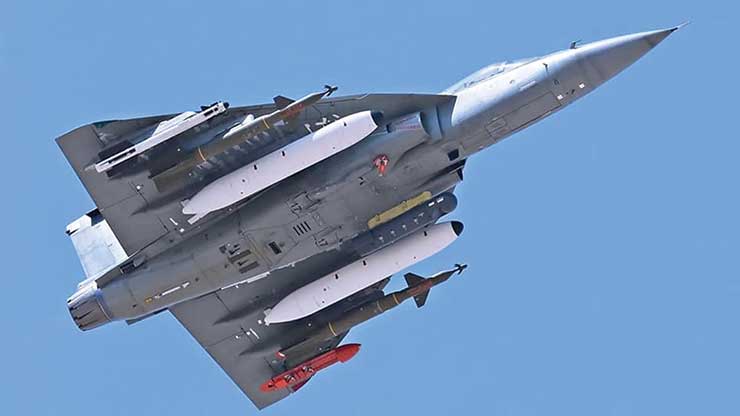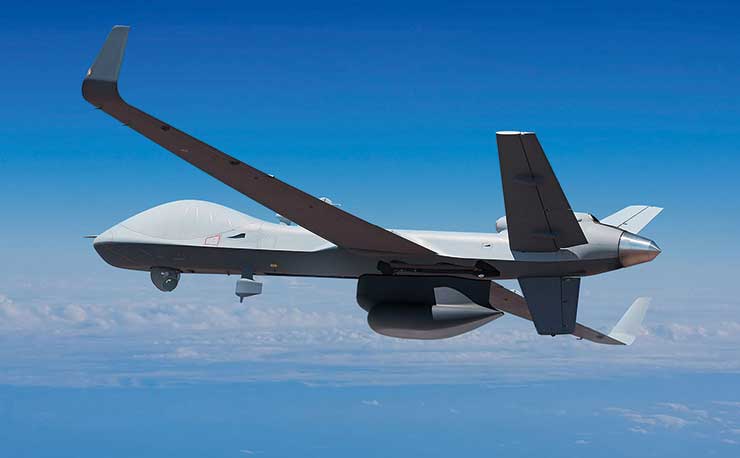
It was a proud moment for India when the first production series of Tejas Light Combat Aircraft (LCA) Mk1A – an advanced version of the LCA Mk1 – completed an 18-minute sortie successfully. It paved the way for the delivery of 83 Mk-1A fighters to commence shortly, for which the Indian Air Force (IAF) placed an order in February 2021.
This feat came close on the heels of Made-in-India weapon systems rolling down Kartavya Path in central Delhi during the Republic Day parade on January 26, 2024. These systems included the Prachanda Light Combat Helicopter (LCH), Nag anti-tank missile, Pinaka multi-barrel rocket, Swathi Weapon Locating Radar, Sarvatra Mobile Bridging systems, Bhishma T-90 Main Battle Tanks, drone jammer system, advanced radio frequency systems, et al.
India has come a long way in designing and developing military equipment and manufacturing equipment under licence from foreign original equipment manufacturers (FOEMs). This is creditable, but it is also a fact that most of the major defence systems manufactured in India – including indigenously designed and developed systems – incorporate to varying extents, imported sub-systems and components that are critical to their operational exploitation.
For example, the indigenous content (IC) in Tejas LCA Mk1A is expected to be more than 70 per cent in the next few years, but the aircraft is powered by F404-GE-IN20 engines, supplied by the American multinational conglomerate, General Electric. Even Tejas LCA Mk2, which the DRDO plans to develop, will be powered by GE 414 Engine, though it will be manufactured in India with 80 per cent transfer of technology from GE Engines. Other locally manufactured aircraft like Su-30 MKI fighter jets and Hawk Trainer aircraft also have a high percentage of IC, but these too are powered by imported engines.
Many land-based and naval platforms also run on imported or foreign-origin engines. For example, the K-9 SP Howitzers, licence-built jointly by L&T and South Korea’s Samsung Techwin at Hazira in Gujarat, are powered by X1,000 horsepower (750 kW) German MT881Ka-500 MTU Friedrichshafen engines and USA-designed Allison 1100-5A3 transmission systems, being licence-built at a facility in Tamil Nadu.
The indigenous content in Tejas LCA Mk1A is expected to be more than 70 per cent in the next few years, but the aircraft is powered by F404-GE-IN20 engines, supplied by the American multinational conglomerate, General Electric. Other locally manufactured aircraft such as Su-30 MKI fighter jets and Hawk Trainer aircraft also are powered by imported engines
As for naval platforms, INS Vikrant, the indigenously designed front-line aircraft carrier is powered by four General Electric LM2500+ gas turbines on two shafts, generating over 80 megawatts (110,000 hp) of power, primarily because after decades of efforts, Defence Research and Development Organisation (DRDO) administered Gas Turbine Research Establishment (GTRE) at Bengaluru has not succeeded in developing aero gas-turbines for military aircraft, or the marine gas turbines, which was to be a spin-off of the main project.
Meanwhile, India has imported or is in the process of importing, major weapons systems and platforms such as Medium Multi-role Combat Aircraft Rafale, Lockheed Martin C-130J Super Hercules four-engine turboprop military transport aircraft, Boeing AH-64E Apache attack helicopters and CH-47 Chinook heavy-lift helicopters, Sig Sauer Assault Rifles, General Atomics MQ-9B SkyGuardian remotely piloted aircraft systems (RPAS), and so on.
No wonder then that the latest March 2024 report of the Sweden-based Stockholm International Peace Research Institute has yet again adjudged India as the largest importer of arms during the period 2019-23, accounting for 9.8 per cent of the global trade, up from 9.1 per cent during the 2018-22 period. It hurts India’s profile as a country with rapidly growing self-reliance in defence production.
The MoD does not attach credence to these reports, arguing instead that the rising expenditure on the procurement of defence equipment from Indian companies – up from 58 per cent of the capital budget in 2021-22 to 75 per cent in 2023-24 – is a truer indicator of growing self-reliance. This notion needs to be discounted, however.
As a matter of policy, MoD prefers Indian companies as prime vendors under acquisition categories like Buy (Indian – Indian Designed, Developed and Manufactured), Buy (Indian), and Buy and Make (Indian). This allows them to tie up with foreign companies for the transfer of technology, obtaining specialist services or importing raw materials or some critical components, to varying degrees, to manufacture the equipment in India. This is also true of the equipment manufactured in India under other categories like Buy (Global – Manufacture in India) and ‘Make’.
Since all payments to the Indian companies are made by MoD in INR, the expenditure on local procurement is rising every year, but this expenditure does not reflect the payments Indian companies make to the foreign vendors for obtaining raw materials, technology, knocked-down kits, components, and other specialist services.
India needs to create an agency on the lines of the Defense Advanced Research Projects Agency (DARPA) of the United States (without necessarily dismantling DRDO) to focus exclusively on the development of critical and futuristic technologies. The Kelkar Committee had recommended the setting up of such an agency in 2005, but the government did not accept the recommendation
This shows that expenditure in INR cannot be an index of self-reliance in defence production as long as the local manufacturers continue to depend on foreign sources for critical components, raw materials, and the like, without which the equipment manufactured in India, even with a very high IC percentage, cannot be operationally ready for use.
Just imagine the impact it would have on self-reliance if, because of geopolitical or other reasons, one of the FOEMs stops the export of aero-engines or their critical components, or terminates the arrangement for licensed production of engines in India. It will undoubtedly be a big blow to the production of aero-engines in India and, by implication, compromise India’s military capabilities.
The real test of self-reliance is the capability to design, develop and produce critical technologies without which the equipment or platform cannot be operationally exploited. If the country has this capability, it will matter little if the IC in a particular equipment, weapon system or platform is low, provided the non-critical components are available from multiple local or foreign sources.

What is impacting India’s march to self-reliance in the real sense of the term, defined as the capability to indigenously design, develop and manufacture all manner of defence equipment required by its armed forces without having to rely on the import of critical technologies to make the equipment ready for operational exploitation?
The main reason, of course, is the way self-reliance is defined and measured. Self-reliance cannot be conflated with local manufacturing of equipment with a high IC percentage. A new approach needs to be developed to measure self-reliance in terms of decreasing dependence on FOEMs for critical technologies.
What is also missing is an appropriate structural and procedural framework. The existing framework is geared more towards acquiring than developing futuristic technologies and undertaking fundamental research.
In the USA, the responsibility for developing emerging technologies for the military is shouldered by the Defense Advanced Research Projects Agency (DARPA). It functions with a small complement of approximately 220 government employees. (However, DRDO has more than 30,000, including 5,000 scientists, in six technical offices, including nearly 100 program managers, who together oversee about 250 R&D projects.) Most of the heavy lifting is done by outside R&D agencies with the DARPA coordinating all those efforts.
This Agency was long seen as an ideal solution for promoting defence R&D in India and the Kelkar Committee had indeed recommended in 2005 the setting up of a Board of Research for Advanced Defence Sciences (BRADS) to function on the lines of DARPA, but inexplicably the recommendation was not accepted by the government.
Be that as it may, the private sector will have to play a greater role in developing critical technologies. Some creditable efforts are being made under the Technology Development Fund and the iDEX (Innovation for Defence Excellence) Scheme, but these disjointed efforts are not focused on major critical technologies like the development of an aero-engine.
The money spent on defence research and development (R&D) also poses a challenge. With a share of just about 6-7 per cent in the overall defence budget, DRDO cannot be expected to work wonders. Therefore, conditions need to be created for the private sector to play a major role in India’s quest for self-reliance in the true sense of the term
The money spent on defence research and development (R&D) also poses a challenge. With a share of just about 6-7 per cent in the overall defence budget, DRDO cannot be expected to work wonders. Finance Minister Nirmala Sitharaman announced in her budget speech on February 1, 2022, that 25 per cent of MoD’s annual R&D budget will be reserved for private companies and start-ups to break the monopoly of the public sector on developing cutting-edge military technology. Given the paltry R&D budget, the money that could be diverted to the private sector would have been insignificant. In any case, the scheme never got activated.
Increased private sector participation can also mitigate the inadequacy of budget outlays. In the USA, 75 per cent of the total R&D funding is by the business enterprises, with the academia, government and other sectors contributing 11, 9 and 5 per cent respectively. China, South Korea, Japan, and Russia are comparable with the USA in this regard.
India, however, seems to be at the other end of the spectrum with 50 per cent of the outlay being contributed by the government, 41 per cent by the private enterprises (of which defence accounts for a negligible proportion), and the remaining by the academia. This needs to change.
To sum up, a different approach is required to measure self-reliance, an appropriate DARPA-like agency needs to be created (without necessarily dismantling DRDO) to focus exclusively on the development of critical and futuristic technologies, and conditions need to be created for the private sector to play a major role in India’s quest for self-reliance in the true sense of the term.
–The writer is a Ex-Financial Advisor (Acquisition), Ministry of Defence. The views expressed are personal and do not necessarily reflect the views of Raksha Anirveda















